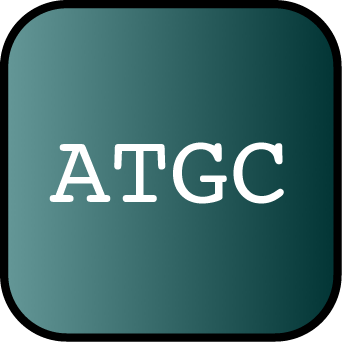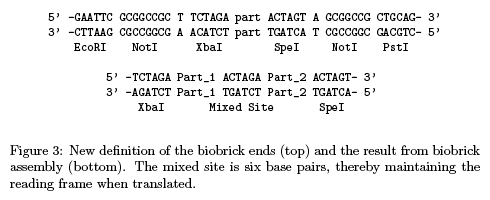Difference between revisions of "Plasmid backbones/Assembly of protein fusions"
(Replacing redirecting link with direct link) |
|||
| (19 intermediate revisions by 3 users not shown) | |||
| Line 1: | Line 1: | ||
| − | [[ | + | [[Plasmid backbones|< Back to Plasmid backbones]] |
| − | {{:Template:Plasmid types}} | + | {{:Template:Plasmid backbone types}} |
| + | <html> | ||
| + | <style> | ||
| + | #assembly_plasmid_table {margin-left:auto;margin-right:auto; border: 3px solid #444444;} | ||
| + | #assembly_plasmid_table td {background-color:#eeeeee; padding: 5px; font-size: 12px;} | ||
| + | #assembly_plasmid_table th {background-color: #aaaaaa;padding: 5px; font-size:14px;} | ||
| + | </style> | ||
| + | </html> | ||
Protein engineers often need to do in-frame assemblies in order to assemble together different signal sequences, proteins domains, and protein tags. BioBrick™ standard assembly is not well-designed for this task because the scar sequence formed by the SpeI-XbaI ligation is 8 base pairs long, so assembly of protein domains causes frameshifts. As a result, different groups have developed modified or alternative assembly schemes to facilitate assembly of protein domains. | Protein engineers often need to do in-frame assemblies in order to assemble together different signal sequences, proteins domains, and protein tags. BioBrick™ standard assembly is not well-designed for this task because the scar sequence formed by the SpeI-XbaI ligation is 8 base pairs long, so assembly of protein domains causes frameshifts. As a result, different groups have developed modified or alternative assembly schemes to facilitate assembly of protein domains. | ||
| + | ==Plasmid backbones that adhere to the Silver standard ([http://bbf.openwetware.org/RFC.html BBF RFC] 23)== | ||
| − | + | {{:Silver standard/Overview}} | |
| − | [[Image: | + | {| |
| + | |[[Image:CarolineAjoFranklingPhoto.jpg|60px|center]] | ||
| + | |Caroline Ajo-Franklin developed the Silver lab protein fusion vectors [[Part:BBa_J63009|BBa_J63009]] and [[Part:BBa_J63010|BBa_J63010]] in Pam Silver's lab. | ||
| + | |} | ||
| + | <br style="clear:both;"/> | ||
| − | + | <parttable>silver_plasmid_backbone</parttable> | |
| − | + | <!-- To include a plasmid in this table, make the part type "Plasmid" and include the categories "//plasmid/proteinfusion //standard/silver" under the Hard Information tab of the part. --> | |
| − | + | ===References=== | |
| + | {{:Silver_standard/References}} | ||
| − | + | ==Plasmid backbones that adhere to the Freiburg standard ([http://bbf.openwetware.org/RFC.html BBF RFC] 25)== | |
| − | + | {{:Assembly standard 25/Overview}} | |
| − | + | ||
| − | + | {| | |
| − | + | |[[Image:RaikGruenbergPhoto.jpg|50px]] | |
| − | + | |Raik Gruenberg developed the protein fusion vectors [[Part:BBa_J18901|BBa_J18901]], [[Part:BBa_J18902|BBa_J18902]] and [[Part:BBa_J18903|BBa_J18903]] that adhere to the Freiburg standard. | |
| − | < | + | |} |
| − | </ | + | |
| + | <parttable>freiburg_plasmid_backbone</parttable> | ||
| − | < | + | <!-- To include a plasmid in this table, make the part type "Plasmid" and include the categories "//plasmid/proteinfusion //standard/freiburg" under the Hard Information tab of the part. --> |
===References=== | ===References=== | ||
| − | + | {{:Assembly standard 25/References}} | |
| − | + | ||
| − | + | ||
| − | + | ||
Latest revision as of 21:10, 29 June 2017
| Part assembly | System operation | Protein expression | Assembly of protein fusions | Part measurement | Screening of part libraries | Building BioBrick vectors | DNA synthesis | Other standards | Archive |
| Or get some help on plasmid backbones. |
Protein engineers often need to do in-frame assemblies in order to assemble together different signal sequences, proteins domains, and protein tags. BioBrick™ standard assembly is not well-designed for this task because the scar sequence formed by the SpeI-XbaI ligation is 8 base pairs long, so assembly of protein domains causes frameshifts. As a result, different groups have developed modified or alternative assembly schemes to facilitate assembly of protein domains.
Plasmid backbones that adhere to the Silver standard ([http://bbf.openwetware.org/RFC.html BBF RFC] 23)
Pam Silver's lab has developed Assembly standard 23, often called the Silver standard, for assembling protein domains. It relies on shortening the BioBrick prefix and suffix each by 1 base pair such that the resulting SpeI-XbaI scar is only 6 base pairs long and protein domains can be assembled in frame.
As shown in figure 3 (right), Assembly standard 23 results in the inclusion of a Thr-Arg (ACT AGA) two amino acid junction between protein domains.
One disadvantage of the Assembly standard 23 is that the codon AGA which encodes Arginine is a rare codon in E. coli. Rare codons can prevent over-expression of proteins in E. coli.
See [http://openwetware.org/wiki/The_BioBricks_Foundation:Standards/Technical/Formats The BioBricks Foundation wiki] for a discussion and comparison of different technical standards.
| Caroline Ajo-Franklin developed the Silver lab protein fusion vectors BBa_J63009 and BBa_J63010 in Pam Silver's lab. |
There are no parts for this table
References
A New BioBrick Assembly Strategy Designed for Facile Protein Engineering
MIT SBWG Technical Reports, 2006 Apr 20
Ira Philips, Pam Silver
[http://hdl.handle.net/1721.1/32535 URL] (open access!)
Plasmid backbones that adhere to the Freiburg standard ([http://bbf.openwetware.org/RFC.html BBF RFC] 25)
The 2007 Freiburg iGEM team proposed an extension of the original BioBrick assembly standard that enables in-frame assembly of protein domains. Two restriction sites are added within the original BioBrick prefix and suffix sites. These additional sites provide compatible ends, can be employed using the same cloning strategy as for the standard restriction sites, and code for amino acids suitable for linkers:
Prefix and suffix
Prefix Suffix
5' GAATTC GCGGCCGC T TCTAGA TG GCCGGC [part] ACCGGT TAAT ACTAGT A GCGGCCG CTGCAG 3'
EcoRI NotI XbaI Met NgoMIV AgeI * SpeI NotI PstI
(=NgoMI)
"N-part" prefix
5' GAATTC GCGGCCGC T TCTAG [ATG.part] EcoRI NotI XbaI
Scar
Assembling two parts based on the new Freiburg standard restriction sites leaves the following scar:
5' [part A] ACCGGC [part B] 3'
T G
See [http://openwetware.org/wiki/The_BioBricks_Foundation:Standards/Technical/Formats The BioBricks Foundation wiki] for a discussion and comparison of different technical standards.
| Raik Gruenberg developed the protein fusion vectors BBa_J18901, BBa_J18902 and BBa_J18903 that adhere to the Freiburg standard. |
There are no parts for this table
References
- [http://hdl.handle.net/1721.1/45140 BBF RFC 25: Fusion Protein (Freiburg) Biobrick assembly standard] by Kristian M. Müller, Katja M. Arndt, the 2007 Freiburg iGEM team, and Raik Grünberg
<biblio>
- Nishikubo pmid=16140408
- Pfleger pmid=16247774
- Varshavsky pmid=8901547
</biblio>
- [http://www.neb.com/nebecomm/products_Intl/productR0564.asp NgoMIV at NEB]













